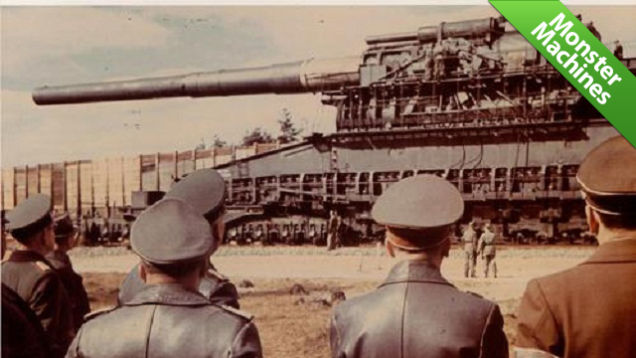It was Adolf Hitler who commissioned the building of the world’s largest gun, the Gustav Gun. In 1939 Hitler couldn’t see a way to get through France’s massive defences along their borders with Germany and Italy. France had built more than 1.5kms of wall defences featuring tank barricades, weaponry and machine gun positions.
Before a weapon could be developed to get through the French defences, Hitler had decided to attack France via Belgium, where the French had little defence mechanisms.
Nevertheless the gun’s development continued, and in 1941 weapons designer and manufacturer Krupp company had developed the Gustav Gun, named after Gustav Krupp the head of the family and Krupp company.
The gun weight almost 1500 tonnes and had to be dismantled before it could be transported since it was too heavy for the railroad tracks in one piece. It was around four storeys high, 20ft wide and around 140ft long. It had a crew of nearly 500 men needed to transport it, set it up and get it ready for firing. It would take around three days to get it ready and prepped for use.
The gun’s barrel was around 80cms and used about 3000lbs of gun powder charge to fire its shells. The gun had mainly two shell types, a 10,500lb high explosive, and a 16,500lb concrete penetrating shell.
The high explosive could hit targets around 30 miles away, and the concrete penetrating shell could reach up to 23 miles. The high explosive could potentially create a 30ft deep crater if it hit its target, while the concrete-buster could get through around 250ft of concrete.
It wasn’t used against France, but the Gustav Gun was used at Sevastopol in Crimea and during the Warsaw Uprising. It fired 300 shells at Sevastopol and 30 at Warsaw. Shortly after it was used, the Gustav was captured by the Allied troops, who destroyed it and used its remains for scrap, the Gizmodo reports.
The Gustav had a cousin gun called the Dora, which cost around DM7 million to make. The Dora was destroyed by the Germans themselves as they didn’t want it to get into the hands of the Soviet troops who were advancing on them. By 1945 it was all over and the Nazi troops had surrendered their war efforts.
